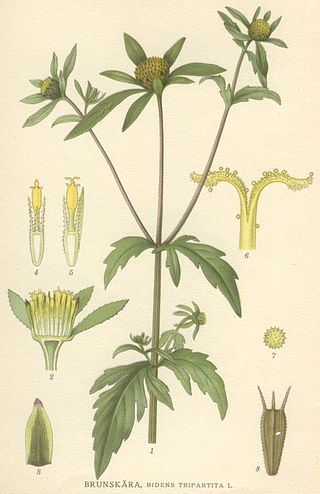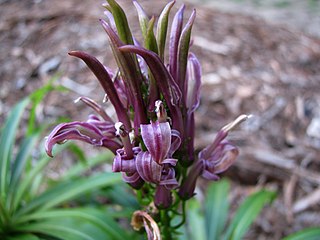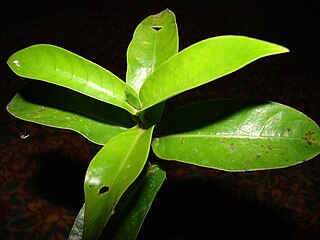
Bidens is a genus of flowering plants in the aster family, Asteraceae. The genus include roughly 230 species which are distributed worldwide. Despite their global distribution, the systematics and taxonomy of the genus has been described as complicated and unorganized. The common names beggarticks, black jack, burr marigolds, cobbler's pegs, Spanish needles, stickseeds, tickseeds and tickseed sunflowers refer to the fruits of the plants, most of which are bristly and barbed. The generic name refers to the same character; Bidens comes from the Latin bis ("two") and dens ("tooth").

Melicope is a genus of about 240 species of shrubs and trees in the family Rutaceae, occurring from the Hawaiian Islands across the Pacific Ocean to tropical Asia, Australia and New Zealand. Plants in the genus Melicope have simple or trifoliate leaves arranged in opposite pairs, flowers arranged in panicles, with four sepals, four petals and four or eight stamens and fruit composed of up to four follicles.
Hawaiian hibiscus are seven species of hibiscus native to Hawaii. The yellow hibiscus is Hawaii's state flower. Most commonly grown as ornamental plants in the Hawaiian Islands are the non-native Chinese hibiscus and its numerous hybrids, though the native Hibiscus arnottianus is occasionally planted.

Coprosma is a genus of flowering plants in the family Rubiaceae. It is found in New Zealand, Hawaiian Islands, Borneo, Java, New Guinea, islands of the Pacific Ocean to Australia and the Juan Fernández Islands.

The Hawaiian lobelioids are a group of flowering plants in the bellflower family, Campanulaceae, subfamily Lobelioideae, all of which are endemic to the Hawaiian Islands. This is the largest plant radiation in the Hawaiian Islands, and indeed the largest on any island archipelago, with over 125 species. The six genera involved can be broadly separated based on growth habit: Clermontia are typically branched shrubs or small trees, up to 7 metres (23 ft) tall, with fleshy fruits; Cyanea and Delissea are typically unbranched or branching only at the base, with a cluster of relatively broad leaves at the apex and fleshy fruits; Lobelia and Trematolobelia have long thin leaves down a single, non-woody stem and capsular fruits with wind-dispersed seeds; and the peculiar Brighamia have a short, thick stem with a dense cluster of broad leaves, elongate white flowers, and capsular fruits. The relationships among the genera and sections remains unsettled as of April 2022.

Wikstroemia is a genus of 55-70 species of flowering shrubs and small trees in the mezereon family, Thymelaeaceae. Hawaiian species are known by the common name ‘ākia.

Labordia is a genus of plant in family Loganiaceae. There are 16 species all endemic to Hawaii. It is closely related to Geniostoma

Schiedea is a genus of flowering plants in the family Caryophyllaceae. It contains 34 species and is endemic to Hawaii.

Lipochaeta, common name nehe, is a genus of flowering plants in the family Asteraceae that is endemic to Hawaii.

Hyposmocoma chilonella is a species of moth of the family Cosmopterigidae. It was first described by Lord Walsingham in 1907. It is endemic to the Hawaiian islands of Kauai, Oahu, Maui, Molokai and Hawaii.

Cyanea is a genus of flowering plants in the family Campanulaceae that are endemic to Hawaii. The name Cyanea in Hawaiian is hāhā.
Phyllostegia glabra is a species of flowering plant in the mint family known by the common name smooth phyllostegia. It is endemic to Hawaii.
Phyllostegia hirsuta is a species of flowering plant in the mint family known by the common names Molokai phyllostegia and hairy phyllostegia. It is endemic to Hawaii, where it is known only from the island of Oahu. It is a federally listed endangered species of the United States.

Stenogyne is a genus of flowering plants in the mint family first described in 1830. The entire genus is endemic to Hawaii.
- Stenogyne strangulationA.Gray - narrow leaf stenography
- Stenogyne bifidaHillebr. - two cleft stenography - Molokai
- Stenogyne methodicalnessA.Gray - bog stenography - Big Island
- Stenogyne cosmicallySherff - Maui
- Stenogyne campanulataWeller & Sakai - Kala Valley stenography - Kauai
- †Stenogyne incinerateHillebr - Maui but extinct
- Stenogyne cranwelliaeSherff - Big Island
- †Stenogyne haliakalaeWawra - Maui but extinct
- Stenogyne kaalaeWawra - Oahu
- Stenogyne kamehamehaeWawra - Molokai, Maui
- Stenogyne kanehoanaO.Deg. & Sherff - Oahu stenography - Oahu
- Stenogyne kauaulaensisK.R.Wood & H.Oppenh. - Maui
- Stenogyne kealiaeWawra - Kauai
- Stenogyne macranthaBenth. - Big Island
- Stenogyne microphyllaBenth. - Maui, Big Island
- †Stenogyne oxygonaO.Deg. & Sherff - Big Island but extinct
- Stenogyne purpureaH.Mann - Kauai
- Stenogyne rotundifoliaA.Gray - pua'ainaka - Maui
- Stenogyne rugosaBenth. - ma'ohi'ohi - Maui, Big Island
- Stenogyne scrophularioidesBenth. - mohihi - Big Island
- Stenogyne sessilisBenth. - Lanai, Maui, Big Island
- †Stenogyne viridisHillebr. - Maui but extinct

Orsonwelles is a genus of American dwarf spiders that was first described by G. Hormiga in 2002. They are all native to the Hawaiian Islands, each species occurring on a single island, often at high elevations. One species has not been collected since the 1890s, and is believed to be extinct. The name honors the actor and film-maker Orson Welles. Many of the species names commemorate elements from Welles' films, radio productions, or roles.
Haplostachys (honohono) is a genus of flowering plants in the mint family, Lamiaceae, first described as a genus in 1888. The entire genus is endemic to the Hawaiian Islands, although 4 of the 5 known species that have been placed in the genus are now believed to be extinct, the fifth listed as "Critically Imperiled."

Phyllostegia haliakalae, commonly known as the Haliakala phyllostegia, is a species of flowering plant in the mint family, Lamiaceae. It was described by Heinrich Wawra von Fernsee in 1872. The species Latin name derives from the Hawaiian word, "haliakala", which means "happy".
Phyllostegia hillebrandii, commonly known as Hillebrand's phyllostegia, is an extinct species of flowering plant in the mint family, Lamiaceae. The name was first used by Horace Mann Jr. in a list of Hawaiian plants published in 1869. It was first described (posthumously) by William Hillebrand in his Flora of the Hawaiian Islands, published in 1888. The species is thought to have gone extinct, although this can't be officially ruled out. It was endemic to the island of Maui, primarily the eastern region, where it was threatened by alien invasive species and deforestation. The last specimens were collected sometime before 1871.













